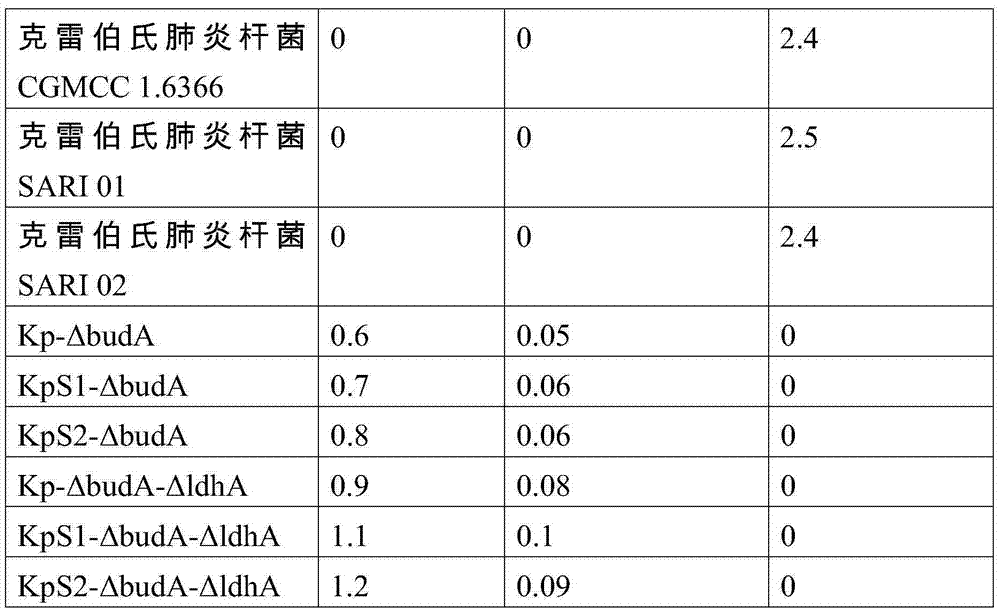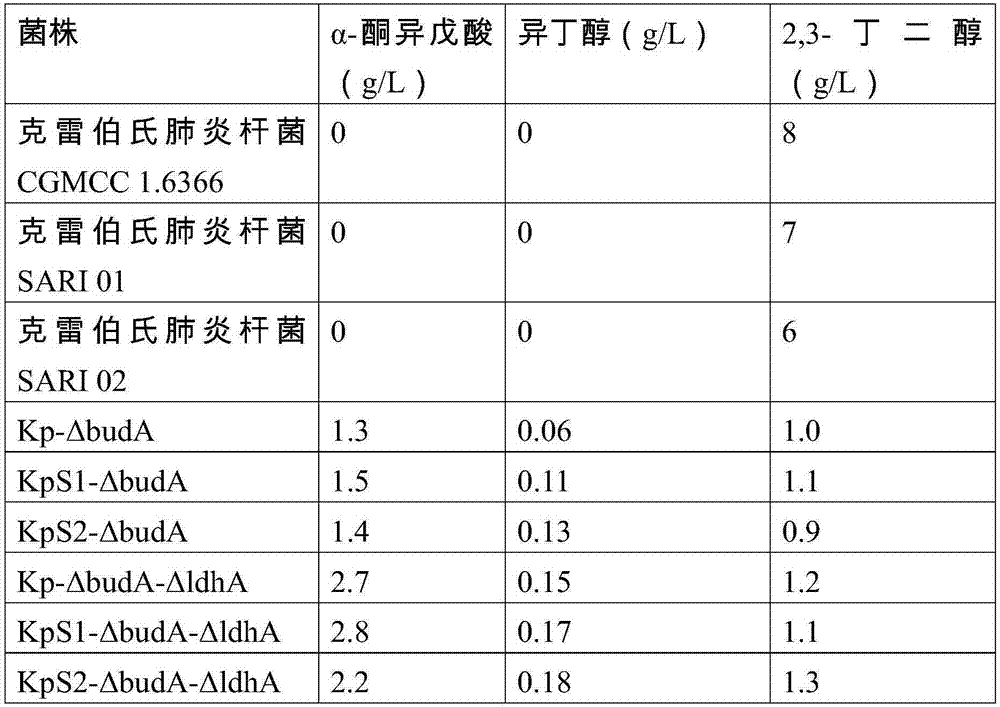Method for preparing alpha-ketoisovaleric acid and isobutanol by adopting klebsiella pneumoniae
A technology of Kneumococcus pneumoniae and ketoisovaleric acid, applied in the field of bioengineering, can solve problems such as undiscovered, and achieve the effect of wide range of raw materials, high genetic stability, and high final concentration of products
- Summary
- Abstract
- Description
- Claims
- Application Information
AI Technical Summary
Problems solved by technology
Method used
Image
Examples
Embodiment 1
[0025] The acetolactate decarboxylase gene of Klebsiella pneumoniae CGMCC 1.6366 strain (the strain is also called TUAC01, AC01) is inactivated by gene recombination to realize the inactivation of acetolactate decarboxylase activity.
[0026] The strain of CGMCC 1.6366 has been disclosed in the published literature (Wei Dong, Wang Min, Shi Jiping, Hao Jian. Red recombinase assisted gene replacement in Klebsiella pneumoniae. Journal of Industrial Microbiology & Biotechnology. 2012 39:1219-1226). This strain is a strain used to produce 1,3-propanediol, 2,3-butanediol, acetoin and 2-ketogluconic acid. The bacterium was isolated from soil, and the isolation process and characteristics are described in (Hao Jian, et al. Isolation and characterization of microorganisms able to produce 1,3-propanediol under aerobic conditions. World Journal of Microbiology Biotechnology 2008, 24:1731-1740).
[0027] 1) The acetolactate decarboxylase gene sequence of CGMCC 1.6366 strain was amplified ...
Embodiment 2
[0045] The acetolactate decarboxylase gene of Klebsiella pneumoniae SARI 01 and SARI 02 strains is inactivated by gene recombination to realize the inactivation of acetolactate decarboxylase activity. SARI 01 and SARI 02 are two strains of Klebsiella pneumoniae isolated from soil by the Shanghai Institute for Advanced Study, Chinese Academy of Sciences. The separation process was the same as described in (Hao Jian, et al. Isolation and characterization of microorganisms able to produce 1,3-propanediol under aerobic conditions. World Journal of Microbiology Biotechnology 2008, 24:1731-1740).
[0046] The pDK6-red plasmid was transformed into SARI 01, and the SARI 01 transformed with the pDK6-red plasmid was named SARI 01-pDK6-red strain. The linear DNA fragment B obtained in Example 1 was electroporated to transform SARI 01-pDK6-red competent cells. Streptomycin was used to screen the resistant strain, and the obtained resistant strain was named KpS1-ΔbudA. The acetolactate de...
Embodiment 3
[0049] A gene recombination method is used to construct Klebsiella pneumoniae in which the acetolactate decarboxylase gene and the lactate dehydrogenase gene are simultaneously inactivated, so as to realize the simultaneous inactivation of the acetolactate decarboxylase and lactate dehydrogenase activities.
[0050] 1) Amplify the Klebsiella pneumoniae lactate dehydrogenase gene sequence by PCR, connect it to a cloning vector by TA cloning method, and perform DNA sequence determination.
[0051] According to Klebsiella pneumoniae 342 genome information, design lactate dehydrogenase gene PCR primers, upstream primer ldhA-s: AGAGCGCACAGGACCACTATCCA (shown in SEQ ID NO.10), downstream primer ldhA-a: TCGGCGAGCTTATAGACCAGCGT (SEQ ID NO.11 shown).
[0052] Through the above primers, Klebsiella pneumoniae CGMCC 1.6366 genomic DNA was used as a template to amplify by PCR to obtain the lactate dehydrogenase gene and adjacent fragments, which were connected to pMD-18T simple plasmid (co...
PUM
 Login to View More
Login to View More Abstract
Description
Claims
Application Information
 Login to View More
Login to View More - R&D
- Intellectual Property
- Life Sciences
- Materials
- Tech Scout
- Unparalleled Data Quality
- Higher Quality Content
- 60% Fewer Hallucinations
Browse by: Latest US Patents, China's latest patents, Technical Efficacy Thesaurus, Application Domain, Technology Topic, Popular Technical Reports.
© 2025 PatSnap. All rights reserved.Legal|Privacy policy|Modern Slavery Act Transparency Statement|Sitemap|About US| Contact US: help@patsnap.com



